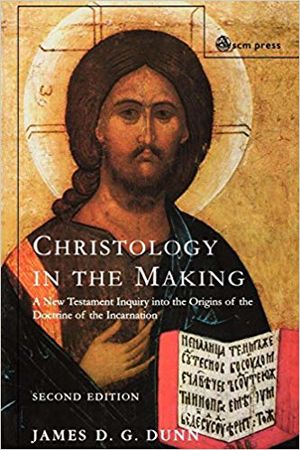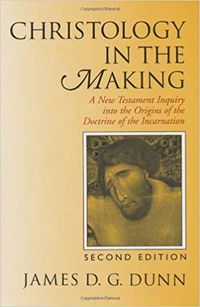Christology in the Making: A New Testament Inquiry into the Origins of the Doctrine of the Incarnation (1980 Dunn), book
Christology in the Making: A New Testament Inquiry into the Origins of the Doctrine of the Incarnation (1980) is a book by James D.G. Dunn.
Abstract
"The New Testament documents cover an intense period of innovation and development in what we now call "Christology." Before Jesus, "Christology" either did not exist, or existed, properly speaking, only in different forms of "messianic expectation." At the end of that period, however, an advanced and far-reaching Christology is already in place that does not hesitate to speak of Jesus as "God." This excellent study of the origins and early development of Christology by James D. G. Dunn clarifies in rich detail the beginnings of the full Christian belief in Christ as the Son of God and incarnate Word. By employing the exegetical methods of "historical context of meaning" and "conceptuality in transition," Dunn illumines the first-century meaning of key titles and passages within the New Testament that bear directly on the develop-ment of the Christian understanding of Jesus. Chosen by Christianity Today as one of the year's "Significant Books" when it first appeared in 1980, this second edition of Christology in the Making contains a new extended foreword that responds to critics of the first edition and updates Dunn's own thinking on the beginnings of Christology since his original work."--Publisher description.
"In this volume Dunn seeks to trace the historical origins of the doctrine of the incarnation. Instead of seeing the doctrine's origins in some parts of the broader religious milieu of Second Temple Period Judaism (such as Enoch's Son of Man, Jewish Angelogy, or Divine Intermediaries) or Greco-Roman mythology (such as the legendary figures Dionysus and Heracles or the Gnostic redeemer myth, as Bultmann did)), Dunn argues that the doctrine originates from the intersection of the Wisdom imagery of pre-Christian Judaism and the NT itself. Accordingly, instead of anachronistically assuming, like his predecessors, that incarnational theology is present within the entire corpus of the New Testament, Dunn argues that the doctrine of the incarnation developed only in second-generation Christianity within the corpus of the New Testament from intimations in the Wisdom passages of Paul's letters (while Paul's primary preoccupation is Adam Christology) to the latter clearly articulated incarnational language found in John 1.14 ... Yet despite Dunn's erudite presentation, clear command of the secondary literature, and close exegetical readings of the New Testament, his work has been and can be critiqued from two antithetical angles. First, after the initial publication of this work in 1980, Dunn, not surprisingly, ignited a fierce backlash among the vast majority of NT scholars, notably, Larry W. Hurtado and Richard Bauckham, at precisely the point where his work is the most revolutionary. In particular these scholars, who held a more traditional viewpoint, contested his exegetical treatments of several key passages such as Phil 2.6-11, Col. 1.15-20, 1 Cor. 15.44-49, Gal. 4.4, and Rom 8.3, since they assumed that these texts supported later theological understandings of a divine, pre-existent Jesus who had become incarnated in human flesh. Although this is still a contentious issue in some scholarly circles, Dunn's presentation of the material at this point is compelling and difficult to refute ... Second, specialists in Second Temple Period Judaism have critiqued Dunn in relation to the dating of key texts from the Pseudepigrapha in general and the Enochic literature in particular. For instance, Dunn's insistence on the primacy of the NT text for the doctrine of the Incarnation forces him to date the Similitudes of Enoch to the end of the 1st century CE and clouds his ability to see antecedents of incarnational theology within this form of Judaism. Instead, he view the Gospel of John, the Similitudes of Enoch, and other texts such as 2 Baruch, which have redeemer figures that pre-existed in heaven prior to their appearance on earth, as contemporaneous texts and seeks to understand this purportedly parallel phenomenon as a common dissatisfaction with and response to the events of 70 CE, rather than a diachronic development. Indeed, if any of these developments can be seen as first or primary, Dunn suggests that it was likely the Christian re-appropriation wisdom imagery that spawned other Jewish religious thinkers to follow suit and not vice versus. In this way, Dunn appears to be motivated by apologetic concerns, preserving the uniqueness of the doctrine of the incarnation for Christianity alone. Yet despite these criticisms, for its time Dunn's groundbreaking argument that incarnational theology developed within the NT, and was not merely monolithic throughout, marked a significant breakthrough in the field and radically reshaped the traditional understanding of the historical development of the Incarnation. ~Deborah Forger, University of Michigan.
Editions
Published in London [England]: SCM Press; and Philadelphia, PA: Westminster Press, 1980 / 2nd ed. Grand Rapids, MI: Eerdmans, 1996.

